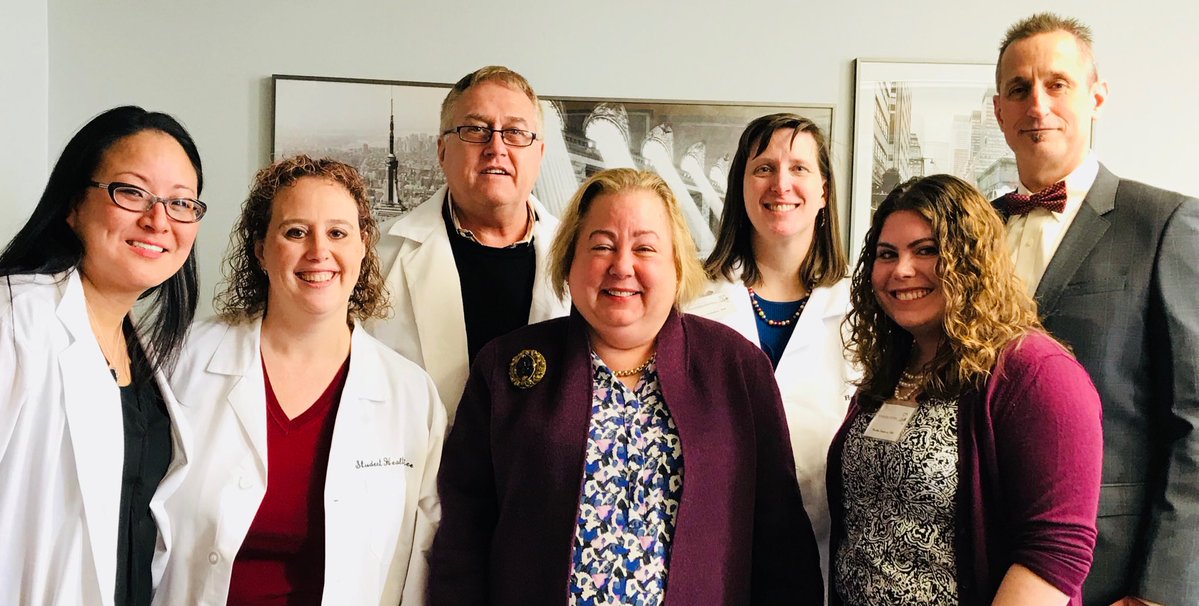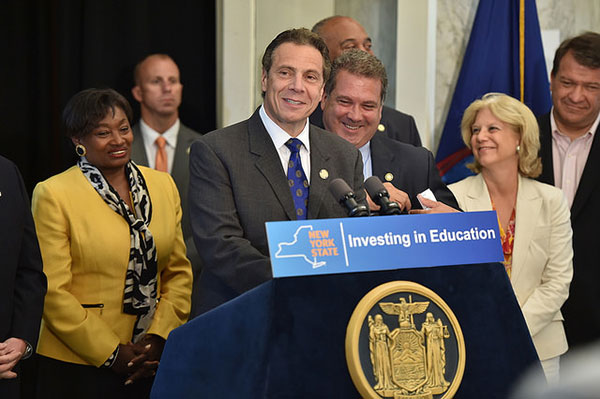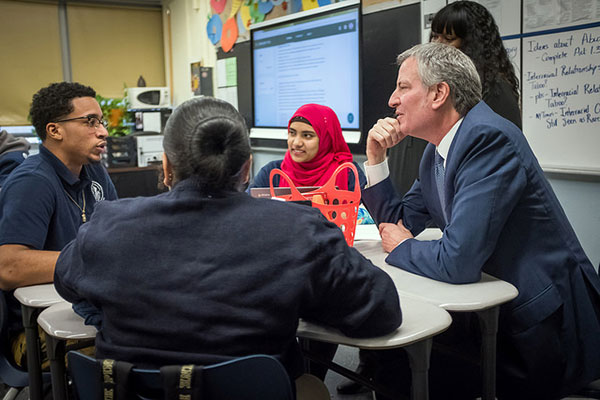3 Ways New York Must Advance Reproductive Rights This Year

Senator Krueger, the author, with doctors (photo: @jmumfordmd)
Note: this column was written and published in March, 2018, several months before Democrats won control of the state Senate through the November elections; they will take the majority in January
On March 13, the New York State Assembly passed three critical bills regarding reproductive health and rights: the Reproductive Health Act (RHA), the “Boss Bill,” and the Comprehensive Contraception Coverage Act (CCCA). Unfortunately, the majority coalition in the State Senate continues to bottle these bills up in committee, as it has for years, preventing them from getting an up-or-down vote on the Senate floor. This obstruction simply cannot continue.
New Yorkers deserve modern laws to protect their deeply personal decisions about reproductive healthcare, and the time to act is now.
Why the urgency, you may ask, when New York is seen as a leader in protecting women’s reproductive rights, and Roe v. Wade continues to be the law of the land?
The simple answer is that there is a war on women’s reproductive rights in our country at the state and federal level, and it has significantly intensified during the Trump Administration. Conservative judges are being appointed to state and federal courts; funding is being redirected from Planned Parenthood to clinics that do not perform abortions, and from evidence-based sex education and pregnancy prevention programs to ineffective abstinence-only programs; laws and regulations seek to chip away at Roe v. Wade and restrict abortion access by creating unnecessary hurdles and criminalizing pregnancy; lack of coverage, high co-pays, and harmful regulations reduce access to contraception.
Even in New York, our reproductive health and rights are at risk because of our outdated and unconstitutional laws.
If a pregnant woman becomes critically ill after 20 weeks, or learns that the fetus is not viable, she must choose among terrible options: travel out of state to get an abortion (if her family can afford the hefty expense); carry to term and risk a dangerous labor to deliver a baby that is stillborn or able to survive only briefly, often in great pain; or possibly face criminal charges for getting the abortion in New York.
Current state law also fails to protect women and men from being fired or otherwise discriminated against by their employer for their reproductive healthcare decisions, whether making the decision to get an abortion, or simply choosing to use contraception. In addition, although access to contraceptive options is instrumental in reducing the number of unintended pregnancies, including teen pregnancies, and leads to families that are planned, safe, and healthy, many New Yorkers face barriers to contraceptive services due to lack of financial resources.
The RHA, the Boss Bill, and the CCCA address these pressing issues.
The existing New York State abortion law was enacted in 1970. It is not based on modern medical practices, and it does not guarantee the same constitutional protections as Roe v. Wade. Passing the Reproductive Health Act (S2796/A1748) would provide for abortion care after 20 weeks if a woman’s life or health is at risk, or if a fetus is not viable. Additionally, the RHA repeals outdated and unconstitutional criminal statutes banning abortion, and moves the regulation of abortion into the public health law, where it belongs, ensuring that New York State law treats abortion as health care and not a criminal act. Reproductive health care decisions should be made by a woman and her doctor – not by politicians or the government.
The Boss Bill (S3791/A566) closes a gap in current workplace anti-discrimination laws. Employees would not need to fear being the target of employer discrimination if they use contraception, get abortion care, or seek other reproductive health services.
The Comprehensive Contraception Coverage Act (S3668/A1378) requires insurance policies to provide coverage for all FDA-approved contraceptive products. Policies are also required to cover emergency contraception, voluntary sterilization procedures, patient education and counseling on contraception, follow-up services, and the provision of a 12-month supply of a contraceptive at one time, without a deductible, co-payment, or any other cost-sharing requirement.
At this critical time when women’s health and reproductive rights are under attack, New York must demonstrate bold leadership and stand up for women’s equality and healthy families. I urge my fellow New Yorkers to hold your Senators accountable. New York families have waited long enough - we can and must pass these bills.
***
Liz Krueger is a state senator representing parts of Manhattan. On Twitter @LizKrueger.
***
Have an op-ed idea or submission for Gotham Gazette? Email This email address is being protected from spambots. You need JavaScript enabled to view it.
Bridge Programs Get Big Results, But Little Support

(Photo: Office of the Governor - Kevin P. Coughlin)
Governor Cuomo’s $175 million workforce development proposal, announced earlier this year, promises major new investments in the skills-building programs that New York needs. With industries like healthcare, tech, and construction facing shortages of skilled workers, the governor’s plan can help expand access to opportunity while boosting the economy.
But for millions of New Yorkers who lack math and literacy skills—including 2 million adults without a high school diploma and 2.3 million who speak English less than very well—gaining entry to effective workforce programs will first require boosting their basic skills. That is the idea behind bridge programs, which help adults with limited formal education acquire the skills they need to transition into training and higher education.
Given the enormous population of New Yorkers with these needs, expanding bridge programs should be part of any statewide workforce development proposal. Ideally, these programs can teach adult basic education in the context of an industry, while building momentum toward a marketable credential. However, fewer than a dozen programs in New York City and just a handful upstate put the full bridge model into practice.
It’s time to change this. New York State should make investing in bridge programs part of its workforce development plan.
Where the model has been implemented, the results are impressive. Bridge programs work for people with limited opportunities and no time to waste. Research has found that bridge programs are effective for students with significant barriers to employment, including those with a reading level as low as the 7th grade.
New York’s leading example is the Bridge to College and Careers program at LaGuardia Community College. Through coursework that focuses on healthcare, science, or business, the program provides meaningful context for the math and literacy skills students need to pass their high school equivalency exams.
LaGuardia’s bridge program has connected with especially vulnerable demographics: About half of its bridge students are 26 or older, almost half are immigrants, and over 50 percent read at a 7th or 8th grade level. Many of these students are balancing commitments that make going back to school particularly difficult, such as multiple part-time jobs and children at home.
A 2013 study by MDRC showed that students in LaGuardia’s bridge program were twice as likely as their peers to pass the high school equivalency exam and three times as likely to pursue a postsecondary degree. The program has proven so effective that other states are using it as a model, notably a new bridge program at Northeast Wisconsin College. But even as Wisconsin imports LaGuardia’s pioneering program, none of New York State’s 35 other community colleges have been funded to offer bridge programs of their own.
Aside from the program at LaGuardia Community College, most of New York City’s bridge programs are run by nonprofit job training and adult education providers. One notable example is Per Scholas, a respected Bronx-based training organization, which partnered with The Door to create a five-week TechBridge program where participants catch up on basic math and English skills before transitioning to Per Scholas’ IT Support job training course.
The landscape of bridge programs is even more limited upstate. One bright spot is CenterState CEO, a business development organization in Syracuse, which integrates math and literacy education into a green construction training program. Likewise, the New York Association for Continuing and Community Education offers adult basic education that bridges into a certified nurse’s assistant training program. Other initiatives organized by community colleges, nonprofits, and intermediaries only use elements of the bridge model—like combining adult literacy programs with pre-college preparation—and are hampered by limited resources and a lack of coordination with industry partners.
Multiplying the capacity of bridge programs will require state leadership. Governor Cuomo and the state Legislature should fund pilot projects at community colleges statewide modeled on LaGuardia’s successful initiative, provide resources to scale up proven programs run by nonprofit providers, and invest in the capacity of business development intermediaries to bring stakeholders together to create bridge programs.
The new state Office of Workforce Development can also organize partnerships among schools, nonprofits, and employers to shape bridge programs that work for the needs of specific regions. As bridge initiatives grow, New York should prioritize programs that implement the full model—offering adult education in an industry context, bridging into a program that offers a postsecondary or industry-recognized credential, and incorporating a credential into the bridge program itself.
New York’s bridge programs serve nowhere near the number of adults who would benefit from them. It’s time for New York to catch up. Building support for the bridge model into the state’s bold new workforce investment plan can help ensure that a shot at economic mobility is accessible to all.
***
Naomi Sharp is a research associate at the Center for an Urban Future, a New York–based think tank focused on expanding economic opportunity. On Twitter @nycfuture.
***
Have an op-ed idea or submission for Gotham Gazette? Email This email address is being protected from spambots. You need JavaScript enabled to view it.
Segregation is Not an Excuse, Mr. Mayor; It’s Opportunity to Lead

(Photo via Ed Reed/Mayor's Office)
Curbed NY recently reported that the vast majority of the affordable-housing units created under Mayor Bill de Blasio’s Housing New York plan are unaffordable to large swaths of the population. The ironic response from New York City’s Department of Housing Preservation and Development (HPD) was that the policy promotes “diverse and integrated neighborhoods.”
This explanation is puzzling, to say the least, for integration advocates. The phrase “integrated neighborhoods” does not appear once in the mayor’s 117-page housing plan, and there is only a single reference to “fair housing.” “Diverse neighborhood” does appear frequently, but only to signify “affordable to more than one income group” - rather than a larger goal of opening neighborhoods where more resources and opportunities are clustered and where few affordable housing units exist.
The administration’s actions speak even louder than its words. Inclusionary housing - as its name suggests - should provide historically excluded populations with expanded housing choices including access to “higher opportunity” neighborhoods. The de Blasio administration flipped this concept on its head with its mandatory inclusionary housing regime - primarily targeting some of the poorest neighborhoods of color for “affordable” housing development with limited opportunities for the lowest-income populations to participate, putting them at considerable risk of displacement and homelessness.
The new law does not even include reasonable guidelines to ensure that affordable housing is built in areas that offer greater educational opportunity. The administration is fighting a lawsuit which seeks to eliminate the City’s outsider-restriction (or “community preference”) policy that appears to violate the Fair Housing Act. Most recently, both HPD and the Human Rights Commission came out to testify against a modest piece of legislation that would have placed reasonable restrictions on housing co-ops to reduce illegal housing discrimination.
For school-integration advocates, this all feels familiar. In 2015, even as Chancellor Carmen Farina repeatedly dismissed the need for proactive school-integration policies, Deputy Mayor Richard Buery actively touted the benefits of classroom diversity to justify the universality of universal pre-K. (Fortunately, towards the end of her tenure the chancellor started to bend and took some important steps forward.)
For fair housing advocates, the City’s actions fail to affirmatively further fair housing and merely continue a long history of actions by government and private real estate interests that effectively reinforce patterns of poverty concentration and residential racial segregation and fuel a vicious cycle of inequality.
The administration invokes diversity and integration when convenient, while largely ignoring the pleas and policy prescriptions of school- and housing-integration experts. Occasionally, the strategy can feel divisive - creating a false opposition between the goals of caring for our most vulnerable citizens and dismantling the structures that produce and sustain racism, poverty, and inequality. At its worst, the strategy suggests that “diversity” is mere cover for an unfettered pro-development agenda that protects the interests of developers and many of the more affluent and predominantly white neighborhoods in the city. In any event, we see too many current school and housing policies as reinforcing the “tale of two cities” that the mayor himself campaigned against.
Continuing residential segregation by race and income is a condition that nourishes a host of inequalities including gentrification. We believe policies that produce meaningful integration in schools and housing are the best antidote to gentrification. As the federal government signals a clear retreat from enforcing the 50-year-old Fair Housing Act, we need local leadership on these issues now more than ever.
As historic demographic changes threaten to transform every aspect of New York City, we urge the mayor to begin exercising real leadership - for New York City and for metro areas across the nation. The integration of our communities is neither a political liability to be ducked, nor a convenient excuse to be exploited; it is an opportunity to lead. Our organizations stand ready to assist and support all efforts to create schools and neighborhoods that are inclusive and equally open to all New Yorkers.
***
Fred Freiberg is executive director of the Fair Housing Justice Center. David Tipson is executive director of New York Appleseed. On Twitter @FredFreiberg of @fairhousingnyc and @AppleseedNY.
***
Have an op-ed idea or submission for Gotham Gazette? Email This email address is being protected from spambots. You need JavaScript enabled to view it.




